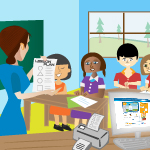Distribute the bags of yarn lengths from the previous lesson. To demonstrate how to create a model, use one student’s yarn and place the yarn strips on the paper to show the height of the student, the length of the leg, the placement of the arm span yarn strip, and the appropriate location of the length from waist to top of the head. Note: Students may need to be reminded that the arm span yarn may not be fully extended. This is true because students can bend their arms to place them by their side. Sample pictures are shown:
.gif)
.gif)
Tape the yarn strips in place and demonstrate how to draw around them to create the outline of the student’s body. Model how to plan the drawing by using visual skills. Be sure to talk about having the leg-lengths begin and end on the same plane (waist). Discuss why the height strip should be placed in the middle of the length of the paper. This focuses the students’ attention on the spatial relationships among the yarn strips, their body, and the map. Some students may have examples of symmetry in their maps.
Note: If appropriate for your students and your curriculum, discuss how the maps demonstrate symmetry.
Group students in pairs and ask them to work together to draw a map of themselves. By working in pairs, students can benefit from collaborative dialogue and the expertise of each. If there is sufficient time for only one student to be measured and mapped, this lesson could be repeated to allow both students a turn.
Have the students complete their map by drawing clothes on their body and labeling: arms, legs, hands, feet, head, and body. The students who remember the lesson from the Going Places Unit, entitled Facing Up, may add detail to their face.
 Going Places Unit
Going Places Unit
 Facing Up
Facing Up
Post the paper student maps in the classroom. Discuss the similarities and differences and strategies used to create a lifelike representation of their body using the yarn strips. Encourage the students to talk about the spatial skills they used to determine the placement of the parts of their body map and relate those placements to the measurements made with the yarn strips.
Questions for Students
1. How did you decide where to attach the yarn to your paper so that it matched your body?
[Student responses may vary.]
2. How did you decide where to place the yarn strips on your paper to make certain that you had enough room on your paper for your body map?
[Student responses may vary.]
3. Which measurements are the same for you and your partner? Which are different?
[Student responses will depend upon their own personal measurements.]
4. What other ways could you use to create a map of yourself that might be easier and more accurate?
[The students may suggest that they lie down on the paper strips and have a partner trace around their body.]
5. What other tools could you use to measure your body? How do they compare with the yarn that you used?
[Students may suggest rulers or yard sticks. Or, they may suggest other nonstandard units, in addition to the yarn they used.]
Teacher Reflection- Which students were able to tape the yarn strips to the paper and effectively use them to create a reasonably proportional map of themselves?
- Which students were not able to tape the yarn strips to the paper to create a reasonably proportional map of themselves? What knowledge and skills did students need for this lesson that they did not demonstrate?
- Which students need to have new challenges to extend their understanding? What would be appropriate mathematical learning experiences for them?
- How successful were students in using the relationship between the left and right sides to create a proportional map? What experiences would help the students understand line of symmetry?
- How successful were the students in using the relationship between the upper torso and the legs to create their map? Are there other lessons that would teach this same idea?